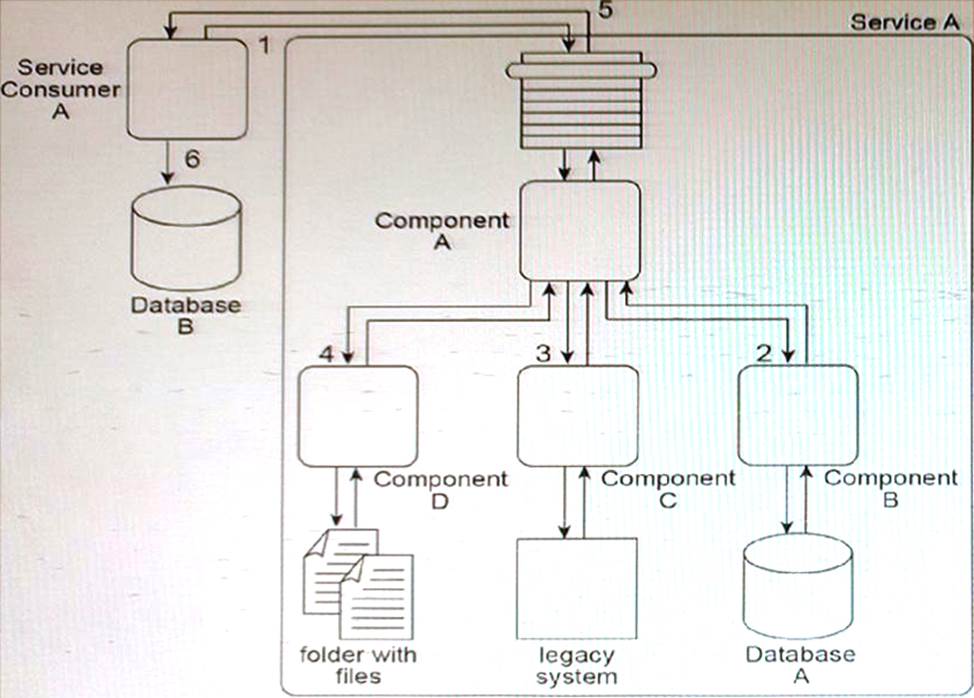- All Exams Instant Download
What steps can be taken to fulfill these requirements?
When Service A receives a message from Service Consumer A (1), the message is processed by Component A. This component first invokes Component B (2), which uses values from the message to query Database A in order to retrieve additional data. Component B then returns the additional data to Component A. Component A then invokes Component C (3), which interacts with the API of a legacy system to retrieve a new data value. Component C then returns the data value back to Component A.

Next, Component A sends some of the data It has accumulated to Component D (4), which writes the data to a text file that is placed in a specific folder. Component D then waits until this file is imported into a different system via a regularly scheduled batch import. Upon completion of the import, Component D returns a success or failure code back to Component A. Component A finally sends a response to Service Consumer A (5) containing all of the data collected so far and Service Consumer A writes all of the data to Database B (6). Components A, B, C, and D belong to the Service A service architecture. Database A, the legacy system and the file folders are shared resources within the IT enterprise. Service A is an entity service with a service architecture that has grown over the past few years. As a result of a service inventory-wide redesign project, you are asked to revisit the Service A service architecture in order to separate the logic provided by Components B, C, and D into three different utility services without disrupting the behavior of Service A as it relates to Service Consumer A.
What steps can be taken to fulfill these requirements?
A. The Legacy Wrapper pattern can be applied so that Component B is separated into a separate wrapper utility service that wraps the shared database. The Asynchronous Queuing pattern can be applied so that a messaging queue is positioned between Component A and Component C, thereby enabling communication during the times when the legacy system may be unavailable or heavily accessed by other parts of the IT enterprise. The Service Fagade pattern can be applied so that a fagade component is added between Component A and Component D so that any change In behavior can be compensated. The Service Autonomy principle can be further applied to Service A to help make up for any performance loss that may result from splitting the component into a separate wrapper utility service.
B. The Legacy Wrapper pattern can be applied so that Component B Is separated into a separate utility service that wraps the shared database. The Legacy Wrapper pattern can be applied again so that Component C is separated into a separate utility service that acts as a wrapper for the legacy system API. The Legacy Wrapper pattern can be applied once more to Component D so that it is separated into another utility service that provides standardized access to the file folder. The Service Fagade pattern can be applied so that three fagade components are added: one between Component A and each of the new wrapper utility services. This way, the fagade components can compensate for any change in behavior that may occur as a result of the separation. The Service Composability principle can be further applied to Service A and the three new wrapper utility services so that all four services are optimized for participation in the new service composition. This will help make up for any performance loss that may result from splitting the three components into separate services.
C. The Legacy Wrapper pattern can be applied so that Component B is separated into a separate utility service that wraps the shared database. The Legacy Wrapper pattern can be applied again so that Component C is separated into a separate utility service that acts as a wrapper for the legacy system API. Component D can also be separated into a separate service and the Event-Driven Messaging pattern can be applied to establish a publisher-subscriber relationship between this new service and Component A. The interaction between Service Consumer A and Component A can then be redesigned so that Component A first interacts with Component B and the new wrapper service. Service A then issues a final message back to Service Consumer A. The Service Composability principle can be further applied to Service A and the three new wrapper utility services so that all four services are optimized for participation in the new service composition. This will help make up for any performance loss that may result from splitting the three components into separate services.
D. The Legacy Wrapper pattern can be applied so that Component B is separated into a separate wrapper utility service that wraps the shared database. The State Repository and State Messaging patterns can be applied so that a messaging repository is positioned between Component A and Component C, thereby enabling meta data-driven communication during the times when the legacy system may be unavailable or heavily accessed by other parts of the IT enterprise. The Service Fagade pattern can be applied so that a fagade component is added between Component A and Component D so that any change in behavior can be compensated. The Service Statelessness principle can be further applied to Service A to help make up for any performance loss that may result from splitting the component into a separate wrapper utility service.
Answer: B
Latest S90.08B Dumps Valid Version with 17 Q&As
Latest And Valid Q&A | Instant Download | Once Fail, Full Refund
Subscribe
Login
0 Comments
Inline Feedbacks
View all comments

